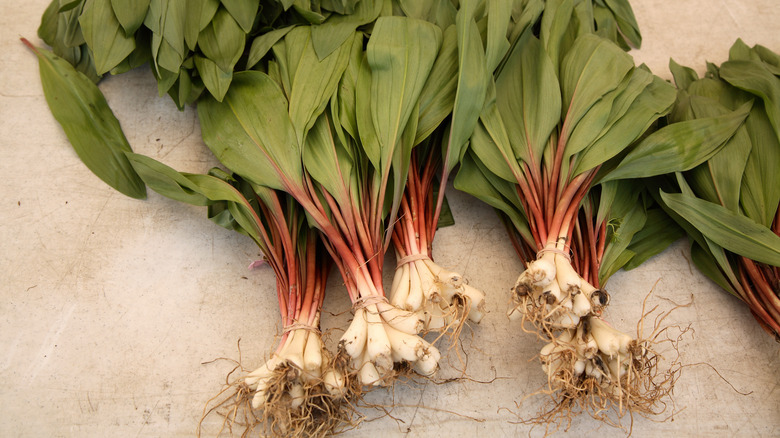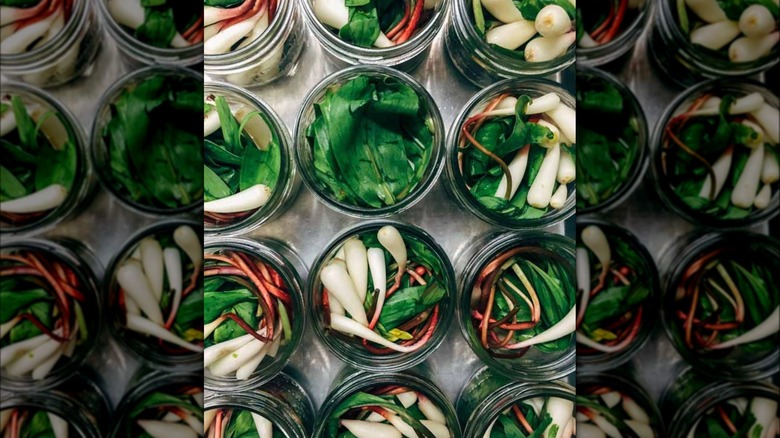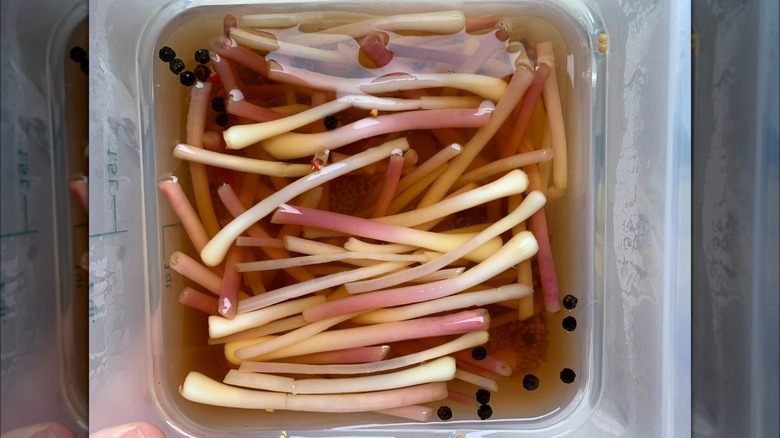How Long Do Pickled Ramps Last In The Refrigerator?
Whether it's the classic crunchy cucumber or starchy potatoes – yes, it's possible to pickle potatoes – pickled foods make for invigorating, zippy, and refreshing snacks. The absolute best part about pickled produce is that just about any fruit or veggie can be pickled, even more obscure greens like ramps. Ramps are an allium vegetable similar in appearance to green onions and likened to the combined flavor of garlic, leeks, and peppery onions. When pickled, they take on a tangy, acidic, and zesty flavor without compromising their fresh garlicky essence. Delicious as they are, though, just how long do pickled ramps last in the refrigerator?
Though it might be tempting to eat your pickled ramps beyond their expiration date, as time passes they lose their vigor and flavor. Because they're not commonly available at most supermarkets and chain grocery stores, that means you'll likely be pickling ramps at home, which means they don't last quite as long as store-bought pickled veggies. However, when properly stored in the refrigerator, pickled ramps stay fresh for at least three weeks.
Proper pickled ramp storage
Because they're so tasty, proper storage is critical for maximizing the lifespan of these pickled allium veggies. While it might feel elementary, reviewing some best practices for refrigeration will get you the most out of your pickled ramps.
Pickled ramps should be stored in an airtight container like mason jars, food storage containers with snap-on lids, vacuum-sealed canisters, or any other container that is labeled as air tight. This step is critical as exposure to air hastens spoilage and increases the amount of time the ramps can be exposed to potential bacteria and pathogens. If you're a forgetful foodie, consider labeling the container with the exact date you pickled the ramps so you can keep track of just how long they've been in your snack and meal rotation.
You should also be mindful of where you place the pickled ramps in the fridge. Keep them away from raw meat, seafood, and other foods that could potentially facilitate cross-contamination — a dangerous food safety mistake. When it comes to the temperature of your trusty refrigerator, keep pickled ramps in an environment that is at least 40 degrees Fahrenheit or colder to maximize freshness and flavor.
Recognizing spoilage
Luckily, pickle brine is great for slowing the growth of bacteria that cause foodborne illness. However, that doesn't mean they can't become hazardous to consume. Knowing how to recognize the signs of spoilage can protect you from eating dangerous pathogens.
Rotten pickled ramps aren't exactly deceptive and you can rely on your senses to determine the quality of freshness. Let's start with the visual cues. If you notice mold, that's an obvious sign that it's time to ditch the ramps. If mold makes its way onto the container, remove the mold immediately before soaking the container in a bleach-water solution for at least 30 minutes. Extreme discoloration or abnormal cloudiness is another visual cue that pickled ramps have taken a turn for the worse. They should be firm and crunchy, so if you notice a slimy, snotty texture, kick them to the curb.
Pickled ramps have a naturally funky smell, but should never take on a rancid, foul, or sour aroma. If you catch a whiff of something beyond its natural aroma, you should make a new batch of pickled ramps. If you believe they've gone bad, it's best to avoid tasting the ramps to determine freshness as this could potentially lead to consumption of bad bacteria, so let your sight and scent do the talking.
Next time you're making your favorite pickled ramp recipe, bear in mind these refrigeration tips so you can enjoy them for a full three weeks. Safe eating is happy eating!


